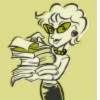 Cushman, Karen. 1995. THE MIDWIFE’S APPRENTICE. New York: Clarion Books. ISBN 0-395-69229-6
Cushman, Karen. 1995. THE MIDWIFE’S APPRENTICE. New York: Clarion Books. ISBN 0-395-69229-6Wanting only food and the warmth provided by a dung heap, Brat’s expectations of life are utterly basic. Karen Cushman takes this character and grows her into a young woman with a name and aspirations of “a full belly, a contented heart, and a place in this world.” The local midwife plucks Brat from a dung heap to serve as her helper. Though initially she is seen as stupid and capable of only the most basic tasks, she grows into an apprentice with a name, Alyce. As Alyce learns she herself is capable and deserving of love, a parallel development is illustrated through her treatment of a stray cat—feeding it, saving it, naming it and loving it. Her innate compassion is the reason she is eventually seen as a valuable person. A local bully, a resident scholar, birthing women, and a young boy each experience Alyce’s kindness. In return, Alyce realizes her worth through their eyes and begins to believe in herself. This story of self determination, is set in a small village during the middle ages. Descriptions of things such as stamped dirt floors and washing linens in the stream allow the reader visualize what life was like. Descriptions of smells and sounds such as a dung heap and crying babies add to the reader’s picture of the era. Without overwhelming the story, Cushman utilizes vernacular common to the day such as “mayhap” and syntax such as “I be no angel” to reflect the times. Rich discussion about the differences and similarities between the middle ages and contemporary life could focus on the trades described in THE MIDWIFE’S APPRENTICE. Contemporary versions of midwives, inn keepers, millers and shepards could be compared to those in the story.
This piece of historical fiction earned the Newbery Medal in 1996 and is highly recommended for readers grades 4-8.

No comments:
Post a Comment